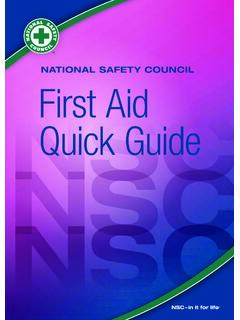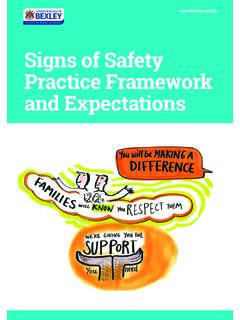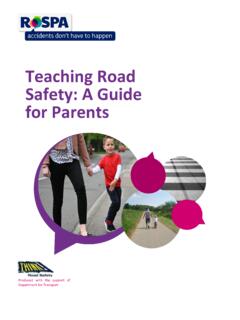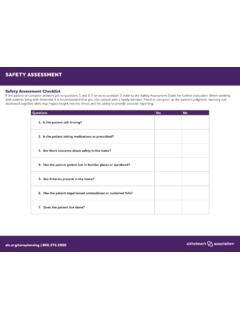Transcription of Mowing and Trimming Safety - Occupational Safety and ...
1 Mowing and Trimming SafetyFor the Landscaping and Horticultural Services Industry2 - Mowing and Trimming SafetyMowing and Trimming SafetyContentsIntroduction What s Inside? ..3 Lesson 1 Take Control of Your Own Safety ..4 Lesson 2 Prepare for Safe Operation ..9 Lesson 3 Preventing Rollover Accidents ..15 Lesson 4 Avoid Being Caught in Moving Parts ..18 Lesson 5 Other Common Dangers ..22 Lesson 6 Environmental Hazards ..27 Conclusion ..34 Quiz Yourself Solutions ..37 Written by: Sara Lind, Information specialistMitch Ricketts, Coordinator, Health, Safety and Environmental Quality, K-State Research and ExtensionDisclaimerThis material was produced under grant number 46G3-HT04 and revised and updated under grant number SH-19503-09-60-F-20 from the Occupational Safety and Health Administration, De-partment of Labor. It does not necessarily reflect the views or policies of the Department of Labor, nor does mention of trade names, commercial products, or organizations imply endorsement by the booklet was produced by K-State Research and Extension, Kan-sas State University, Manhattan, information in this publication has been compiled from a vari-ety of sources believed to be reliable and to represent the best current opinion on the subject.
2 However, neither K-State Research and Exten-sion nor its authors guarantee accuracy or completeness of any infor-mation contained in this publication, and neither K-State Research and Extension or its authors shall be responsible for any errors, omis-sions, or damages arising out of the use of this information. Additional Safety measures may be required under particular and Trimming Safety - 3 This booklet teaches important Safety practices to follow when Mowing . You may use a wide range of equipment including: 4agricultural mowers4riding lawn mowers4walk behind mowers4string trimmers4brush trimmersSafety tips, along with real accident reports, have been combined to give you a better understanding of the risks associated with this type of this booklet in conjunction with hands-on Safety training and the equipment operator s s Inside?
3 4 - Mowing and Trimming SafetyLesson 1 Objectives1. Name the most common types of serious accidents involving mowers and Interpret the meaning of common warning signs and Identify appropriate protective Control of Your Own SafetyGreatest DangersFailure to observe Safety precautions when operating Mowing equip-ment can result in serious injury or death. The most common types of serious accidents are:1. RolloversAgricultural mowers and riding lawn mowers can overturn, caus-ing injury and Being Caught in Moving PartsSerious injury or death can result from being caught in Mowing equipment s moving of OSHA Accident Inspection 107975153A worker was operating a riding mower on a hill. He was Mowing too fast and made a sharp turn, causing the mower to tip over. The mower landed on top of him, crushing his rib cage, punctur-ing his lungs and killing make sharp turns at high speeds, especially on a ReportOperator Crushed by Riding MowerSummary of OSHA Accident Inspection 119815108An employee was operating a riding mower in a parking lot.
4 The mower slipped off the curb. Without shutting off the engine, the employee and a coworker tried to lift the mower. One of the em-ployees put his hand under the front of the mower and lost three fingers at the first put hands or feet under a running mower. Always shut off the mower and disconnect the spark plug before servicing or reaching under the mower ReportEmployee Loses Finger While Lifting MowerMowing and Trimming Safety - 5 Help YourselfSafe work habits are important. Here are three actions you can take to be safe on the job Learn All You Can. To prevent accidents with mowers and trimmers, read and follow directions in the equipment operator s manual. Pay attention to Safety instructions in the manual and to warning labels you see on the equipment. If you have questions, stop and ask your supervisor before you Concentrate on Working you may be tempted to take risky shortcuts.
5 Remem-ber that an accident can leave you permanently injured or cut your life short. For your Safety and the Safety of those around you, do not take unnecessary risks. No deadline is so pressing you can t take the time to do your work Additional not operate machinery if you are tired or have taken drugs or alcohol. If you are on medication, discuss with your doctor or pharmacist if you are capable of safely operating machinery. Choose safety6 - Mowing and Trimming SafetySafety Messages and SignsManufacturers put important Safety messages on Mowing equipment and in the operator s manual. It is critical to read, understand and follow all Safety triangle shape is the symbol for caution. The exclamation mark in the center means Pay Attention. In some instances, the triangle-shaped sign will show a picture. Other times, words explain why the sign is Safety messages use the words Caution, Warning and Danger to get your attention.
6 Following are Safety messages and their mean-ings. Each of these signs will have a written message, and perhaps a picture, about an unsafe means you need to be careful. Follow the directions on the sign or you could get hurt. WARNING is more serious and means you need to follow the direc-tions on the sign or you could be badly hurt or killed. DANGER is the most serious Safety message. If you don t follow the directions, you will be seriously injured or !EYEPROTECTIONREQUIREDWARNING!YOU CAN BECOMECAUGHT IN THEEQUIPMENT SMOVING PARTS.'ANG(R!ENTANGLEMENT IN PTO SHAFT CAN SERIOUSLY INJURE OR KILL displayed in the caution, warning and danger boxes have been recre-ated from images taken with permission from ASAE , FEB1999 (R2005), Safety and Trimming Safety - 7 Protective EquipmentCertain equipment is necessary to protect your body from materials ejected from the Mowing equipment and from being caught in mov-ing parts.)
7 When operating Mowing equipment you should wear the clothes and no jewelry Loose shirt sleeves, pant legs or jewelry can catch in the equipment s moving parts, resulting in injury; therefore, close-fitting clothes should be worn. Pull back long pants and sturdy, non-slip boots Wear long pants, and sturdy, non-slip boots to protect your legs and feet from objects that are thrown from the mower. Never wear sandals, which expose your feet, or tennis shoes, which can easily be severed if caught under the mower deck or in the trimmer s cutting glasses and a face shield Safety glasses should be worn at all times unless operating equip-ment with an enclosed cab. A face shield should be used, in addition to Safety glasses, when operating a string/brush trimmer and other times when your face could be hit by protection Over time, you will lose your hearing if you are exposed to loud noises without protection.
8 Two common types of hearing protection are muffs and plugs. Ear muffs should seal around your ears to properly muffle loud noises. Reusable ear plugs should be washed with warm, soapy water after each use in order to prevent infection. Disposable ear plugs should be discarded after each to Wear Hearing ProtectionOSHA Standard (i) (l) requires hearing protection to be worn when sound levels exceed certain limits (generally, a daily average of 85 or 90 decibels, depending on the circumstances). These levels can be measured with a sound level meter. A hearing conservation program requiring hearing tests and other precautions may also be necessary. Check with the equipment operator s manual, as well as your supervisor, for suggestions on hearing protection for each piece of equipment as well as instructions on how to wear it Protection Rules of ThumbHearing protection may be needed if:4 You have to raise your voice significantly to be heard by someone three feet leaving a noisy area, your ears feel plugged or you hear a mild ringing or whooshing noise that goes away after an hour or you start your car in the morning, the radio is so loud from the evening before that you have to turn it of OSHA Accident Inspection 119806867An employee was Mowing grass with a tractor, but was not wearing Safety glasses.
9 He looked back and a piece of metal was thrown from the mower and punctured his right eye. He lost all vision in that wear eye protection when operating all mow-ing ReportEmployee s Eye Cut by Flying Debris8 - Mowing and Trimming SafetyQuiz YourselfCircle the correct can be found on page What are the two most commonly reported causes of serious injury and death from operating mowers and trimmers?a. Rollovers and being caught in moving Heat stroke and lightning Carbon monoxide poisoning and the correct answer for the following sentences from the list Danger b. Safety glassesc. Alcohold. Caution2. The triangle shape is the symbol for _____ should always be worn when operating Mowing Never operate any type of equipment under the influence of _____ or _____ is the most serious Safety message. Circle the correct When operating Mowing equipment, it is important to wear clothes that are Expensiveb.
10 Close-fittingc. Ironed7. Wear _____ to protect your feet when Mowing and Sandalsb. Tennis shoesc. Sturdy bootsMowing and Trimming Safety - 9 Pre-Start InspectionSafety starts before the engine. A thorough inspection of the mower or trimmer is important before beginning work each day. Use the checklist on the next page as a guide for daily, visual inspections. Alert your supervisor if you find anything wrong during your daily pre-start for loose or damaged belts. Loose belts can slip, causing fric-tion and a possibly a fire. Belts can also break and be flung from the mower. Tighten loose belts and replace belts if any ply separation or cracks are sure the blade is secure, balanced and covered to prevent in-jury. Report bent, cracked or worn blades to your supervisor. Protect your hands with heavy-duty gloves when inspecting LeaksFluid leaks can be a fire hazard as well as cause break-downs.
















